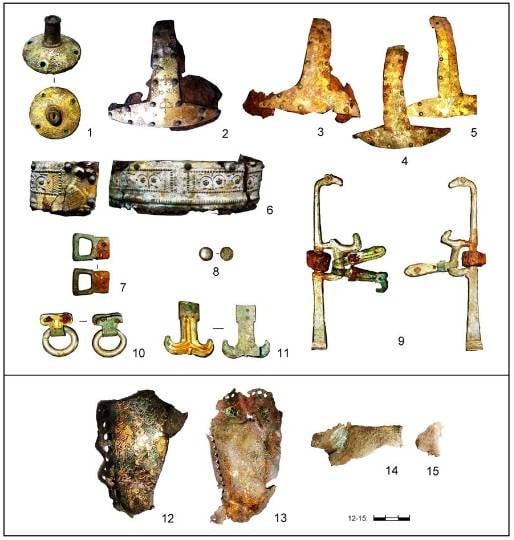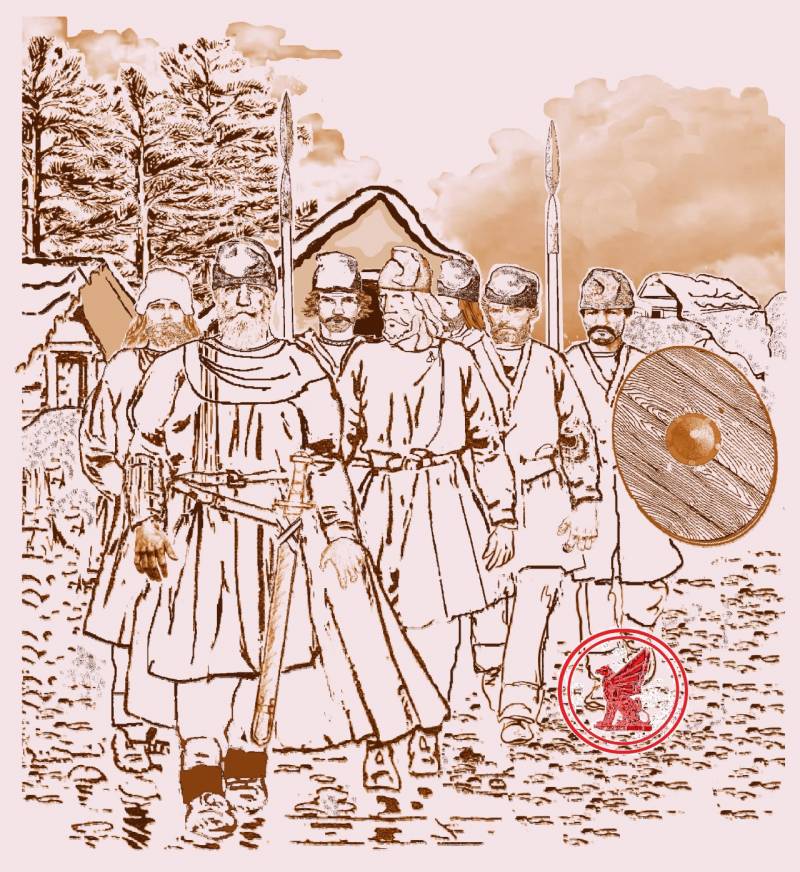The clan and military organization of the early Slavs of the VI — VIII centuries
Entry
This is a sequel cycle of our work at "VO"dedicated to the early political or rather military-political stories early Slavs.
We will consider the military organization, weapons and tactics of the Slavs of this period, based on historical sources.
What was the military organization of the early Slavs? I would like to consider controversial issues related to it in a number of articles, starting with this one.
First of all, it must be said that the Slavic military invasions represented a real military threat to Byzantium. As a result, a whole chapter was devoted to them in the "Strategicon of Mauritius" (without relativity about the authorship of this military work). Although many other enemies of the empire did not receive such an honor, for example, the Arabs, who literally thirty to forty years later capture the entire east of the empire. This was emphasized by the outstanding specialist in military Byzantine history, V.V. Kuchma. But what kind of military system was this, not from the tactical point of view of that period: “army” (Στράτευμα or Στpατός) or “crowd” (“Ομιλoς), but in terms of organization?
Society and military organization
The military organization, especially during the period under review, directly derives from the social structure. Actually, the sources do not allow us to speak clearly about the level of development of certain tribes of this period, but related disciplines (anthropology, ethnography, and partly archeology) indicate, by indirect signs, landmarks.
In previous articles on “VO”, we noted the fact that Slavic society was at an early stage of pre-state development — it was a tribal society or an early stage of “military democracy”, as was commonly believed in the middle and second half of the XNUMXth century.
Along the way, we note that such concepts as “controlled anarchy” or “segmental society” are still trying to apply to this period of Slavic history, but these concepts are not particularly clear (M. Nistazopulu-Pelekido, F. Kurt).
Byzantine authors saw in the Slavic tribes a society that “is not controlled by one person, but since ancient times have lived in democracy (democracy),” as Procopius of Caesarea wrote, and as the author of the Strategicon added:
Despite the significant threat that the Slavs posed to Constantinople, at the same time we see that they were significantly inferior to the neighboring peoples in armament and military art.
What is the reason?
The “backlog” of the Slavs militarily from their neighbors, primarily the Germans, and the nomadic peoples, consisted precisely in the fact that they were at different stages of social development. Roughly speaking, the Slavs at the beginning of the VI century, very appraisally, were at the same phase as the West Germanic tribes in the XNUMXst century. BC.
It is this situation, again due to the late, in comparison with the German ethnos genesis of the Slavs as such, and their institutions in particular, was obviously reflected in military affairs. Simply put, if you live by birth and you are surrounded by similar societies, then you simply do not need chain mail and swords, it’s enough for you weaponswhich is used in the hunt. However, you have neither technological nor material opportunities to have it.
That is, in a settled Slavic society there was no need for additional weapons, except for that which was used in production activities: an ax - everywhere; spear, bow and arrow - on the hunt.
As for the nomadic peoples with whom the Slavs had contacts, even assuming the fact that they were at a similar social stage, due to the development of military technologies and governance structures, nomads dominated the farmers. But these same factors subsequently became the most important reasons for the social lag of nomadic peoples (the development of technology did not lead to a change in society).
And if the society of the Sarmatians and Alans was more or less close in social structure to the early Slavs, then the Huns, and even more so the Avars, were familiar with a higher order management system, which we wrote about in previous articles on VO.
And one more addition. A natural question arises: why did the Proto-Slavs or the early Slavs, having contacts with neighbors who had advantages in military technology, could not borrow them, for example, from the Sarmatians or the Goths?
In the VI century. sources, both written and archaeological, tell us about the same simple set of weapons among the Slavs, as before. It seems that the answer here is simple: like in our days, military technology, sources of raw materials for them were seriously guarded by the owners of those: the sword could be captured or received as a gift, but it was either difficult or impossible to copy. And as Jordan emphasized, the Ants compensated for the lack of armament with a numerical advantage [Getica 119, 246].
With the growth of the population, the surrounding resources were not able to feed the clan or family, which caused the need for a “surplus product”, which was obtained through military operations, this encouraged Slavic society to move and change, but we must take into account that changes in the clan system are extremely slow , and this is directly related to military affairs and weapons.
Tacitus reported the armament of the Wends - Proto-Slavs, which, according to many researchers, in the XNUMXst century AD they are:
[Tacit. G. 46.]
We will learn about the same weapons in a few centuries. Even the involvement of the Proto-Slavic and Early Slavic tribes, first by the Goths, and later by the Huns, in the migration movement did not lead to changes in armaments (we will discuss weapons in detail in subsequent articles).
More than once on the pages of the sources of this time we come across information about the "national" weapons, not to mention the "national" clothes of various tribes. In the "Chronicle of Fredegar" it is reported that the ambassador of the Franks, in order to get to the Slavic king Samo, had to change into Slavic clothes.
Here a significant factor was the social moment, which formed the military organization of the Slavs and indirectly influenced the armament.
So, Slavic society was at an early stage of a tribal system with signs of “controlled anarchy”, as written by Byzantine authors (Evans-Prichard E., Kubel L.E.).
When considering the organization of the troops, we proceed from the well-known military structures of the Indo-European ethnic groups during the transition of society to the pre-state and early state stages. And they consisted of the following parts: squads of the military leader; sometimes, there were independent military organizations, such as secret and age-gender militarized unions; gangs, robber organizations (such as berserkers). Some of them could later be transformed into squads of the prince as ruler. And finally, the main was the militia of the entire tribe.
As this was the case with the early Slavs, we consider below.
In this article we will study the situation with the Slavic "nobles" or the military aristocracy, in the next article - the question of the prince and the squad in the VI-VIII centuries.
Military know
For the emergence of a squad or professional "military-police" organization, an important condition has always been the presence of legitimate leaders in large numbers, but the Slavic clan organization at this stage did not imply such a system. Neither written nor archaeological sources give us such information, and at the following historical stages we also do not observe these institutions. In contrast to, for example, the Homeric Greeks with a huge number of “heroes” and basileus or Scandinavia, where already in the Wendel period (VI-VIII centuries) there were a lot of local, territorial and, in addition, “sea” ones, which contributed to the creation of this system with the aim of as a struggle between themselves, and for campaigns in other lands in the name of glory and wealth. And Tacitus portrays German society to us with well-established princely squads and nobles, who lead an idle lifestyle in non-warfare.
We see nothing of this in the Slavic society of the period under consideration.
It is worth paying attention to the episode with a certain captive Helbudiy (who was a native ant), bought by one ant from the Sklavins, his name was consonant with the name of the Romance commander, and this ant wanted to secretly return him for money to Constantinople, thinking that he was a commander. When “the rest of the barbarians” found out about this, almost all the Antes gathered who legally believed that the benefits from the liberation of the Byzantine “stratig” should go to everyone. That is, for this tribal society it is still difficult to talk about the concentration of treasures among individuals, all the riches captured are distributed by means of fortune-telling, and we do not know what a separate share of the leader is at this stage.
Antian leaders Mezamer or Mezimir, Idarisius, Kelagast, Dobet or Davrit, mentioned under 585, and the “ricks” of Ardagast (end of the 593th century), whose name, perhaps, is not accidental in origin, according to one version, from the god Radegast, just like Musoky (764), and Kiy is the obvious leader of a clan or tribe, not a separate squad. The same can be said of the Slavic archons, the northerner Slavun (765-799), Akamir, who participated in the conspiracy of the Byzantine nobility in XNUMX, and Nebula, who fought in Asia.

With the siege of Thessaloniki at the beginning of the VII century. Slavic tribes were commanded by the “exarch” Khatson, but his power was conditional, the leaders of the tribes obeyed him insofar as one could not speak of any control system. And as Mauritius Stratig wrote at the beginning of the XNUMXth century, "because they have many leaders who disagree with each other." That is, historical documents captured the earliest stage of the formation of the "nobility", "Nobility" among the Slavs, the same process took place among the Germanic tribes on the Roman border about six centuries earlier, when persons who played the most outstanding stood out from the ranks of free tribesmen role in organizing the military defense of the tribe ”(A. Neusykhin).
In this regard, it is worth paying attention that, according to the names, it was the tribal leaders with military functions, and not the military, and even more so the political leaders - the princes: the leader of the Alpine Slovenian Valucca, who headed the Alpine Slavs and Sorbians during the reign of Samo - the origin of the name is from "the great, old", and the head of the sorbs of Dervan is from "old, senior." Moreover, the second edition of the “Annals of the Franks” speak of the “king” of Dragovit (end of the XNUMXth century):
We believe that the translation “Tsarek” does not reflect the real situation, of course, we are talking about the princes of the tribes that were part of the Union of Wilts or Velets. Thus, this is another significant evidence that the head of the tribal union is a typical leader of the tribe, possessing nobility and authority due to his age and experience, and not exclusively a military leader.
Such a society needed a military leader during campaigns and migrations. And we even have indirect evidence of how the choice of such a “prince” took place. This ceremony has been preserved in several Slavic countries, of course, having undergone significant changes. In the Late Middle Ages in Carinthia or Korushki (in Slovenian), a ceremony of choice (last time in 1441), festive-formal rather than real, took place with the participation of the whole people, while in Croatia and Serbia - only in the presence of nobles (zupans) , bans, sotsky, etc.).

It is hardly possible to agree with those who believe that this was due to the fact that the Franks destroyed the patrimonial nobility of the Slovenes while in Croatia it was preserved. Most likely, Croatian society went further into development, and an unnecessary element of the formal participation of “the whole” people was excluded. Initially, in this process, the whole nation or free farmers, kozeza, played a key role, and the procedure was as follows: the oldest kozez sat on the Prince's stone - the throne, under which a piece from an ancient Roman column was used. It can be assumed that earlier this action was performed by an elder - the head of the clan or the head of the tribe. A spotted bull and a mare stood with him. Thus, there was a transfer of “power” or “military power” - to the prince or leader. The ruler was tied up in a folk costume, handed a staff, a symbol of perhaps the judiciary, and he, with a sword in his hand, climbed the throne, then he turned to each of the four cardinal points. Turning to the sides of the world meant that enemies coming from either side would be defeated. In the XV century. the ceremony went to church, after which the ruler sat on a stone throne, standing on the Goslosvetsky field in Krnsky Castle, previously it was the Roman city of Virunum, in the province of Norik, now the valley of Zollfeld, Austria.
In this ceremony, of course, you can see the features of the early election of military leaders, the period of military migration of the Slavs.
Thus, we can clearly say that during the period under review, tribal institutions did not single out from their midst either a sufficient number of military leaders, or a residual number of soldiers living solely due to their military craft. Society did not need such a structure, and could not afford it.
Princely power becomes decisive for society when it stands above a tribal organization, and in order to carry out its normal functioning a squad is needed as an instrument for pursuing politics and suppressing conservative tribal institutions.
This stage in the Slavic society of VI-VII, and, possibly, in the VIII century. not yet arrived.
Sources and Literature
Helmold from Bosau Slavic Chronicle. Translation I.V. Dyakonova, L.V. Razumovskoy // Adam of Bremen, Helmold from Bosau, Arnold of Lubeck Slavonic chronicles. M., 2011.
Jordan. On the origin and deed of the Getae. Translation E.Ch. Skrzhinsky. SPb., 1997. P.84., 108.
Cornelius Tacitus On the Origin of the Germans and the Location of the Germans Translation Babichev AS, ed. Sergeenko M.E. // Cornelius Tacitus. Composition in two volumes. St. Petersburg, 1993.
Procopius of Caesarea War with the Goths / Translation S.P. Kondratiev. T.I. M., 1996.
Mauritius Strategicon / Translation and commentary by V.V. Kuchma. St. Petersburg, 2003. S.196 .; Procopius of Caesarea War with the Goths / Translation by S.P. Kondratiev. T.I. M., 1996.
Theophanes the Confessor Translation G.G. Litavrin // Codex of the oldest written news of the Slavs. T.II. M., 1995.
Chronicle of Fredegar. Translation, comments and entry. Article by G.A.Schmidt. SPb., 2015.
Brzóstkowska A., Swoboda W. Testimonia najdawniejszych dziejów Słowian.— Seria grecka, Zeszyt 2.— Wrocław, 1989.
Curta F. The Making of the Slavs: History and Archeology of the Lower Danube Region, c. 500-700. Cambridge, 2001.
Nystazopoulou-Pelekidou M. "Les Slaves dans l'Empire byzantine". In The 17th International Byzantine Congress. Major Papers. Dumbarton Oaks / Georgetown University, Washington DC, August. NY. 1986.
Gurevich A.Ya. Selected Works. T.1. The ancient Germans. Vikings. M-SPb., 1999.
Kubbel L.E. Essays on political ethnography. M., 1988.
Naumov E.P. Serbian, Croatian and Dalmatian zones in the VI-XII centuries .// History of Europe. Medieval Europe. T.2. M., 1992.
Neusykhin A.I. Problems of European feudalism. M., 1974.
Sannikov S.V. Images of royal power of the era of the great migration of peoples in West European historiography of the VI century. Novosibirsk 2011.
Khlevov A.A. Harbingers of the Vikings. Northern Europe in the I-VIII centuries. SPb., 2003.
Shuvalov P.V. Urbikiy and the “Strategicon” of Pseudo-Mauritius (part 1) // Byzantine Temporary. T. 61.M., 2002.
To be continued ...
- Vashchenko E. Ph.D.
- Slavs and the First Bulgarian Kingdom in the VII-VIII centuries
The origin of the Slavs
Slavs and the beginning of the Great Migration
Slavs and Avars in the VI century
Slavs on the Danube in the VI century
Slavs, Avars and Byzantium. The beginning of the VII century
Slavs on the threshold of statehood
The first state of the Slavs

Information